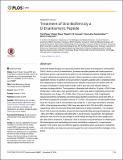| dc.contributor.author | Zhang, Tian | |
| dc.contributor.author | Wang, Zhejun | |
| dc.contributor.author | Hancock, Robert E. W. | |
| dc.contributor.author | Haapasalo, Markus | |
| dc.contributor.author | de la Fuente Nunez, Cesar | |
| dc.date.accessioned | 2017-04-10T15:24:25Z | |
| dc.date.available | 2017-04-10T15:24:25Z | |
| dc.date.issued | 2016-11 | |
| dc.date.submitted | 2016-08 | |
| dc.identifier.issn | 1932-6203 | |
| dc.identifier.uri | http://hdl.handle.net/1721.1/108007 | |
| dc.description.abstract | Almost all dental diseases are caused by biofilms that consist of multispecies communities. DJK-5, which is a short D-enantiomeric, protease-resistant peptide with broad-spectrum anti-biofilm activity, was tested for its effect on oral multispecies biofilms. Peptide DJK-5 at 10 μg/mL effectively prevented the growth of these microbes in culture media in a time-dependent manner. In addition to the prevention of growth, peptide DJK-5 completely killed both Streptococcus mutans and Enterococcus faecalis suspended from biofilms after 30 minutes of incubation in liquid culture media. DJK-5 also led to the effective killing of microbes in plaque biofilm. The proportion of bacterial cells killed by 10 μg/mL of DJK-5 was similar after 1 and 3 days, both exceeding 85%. DJK-5 was able to significantly prevent biofilm formation over 3 days (P = 0.000). After 72 hours of exposure, DJK-5 significantly reduced and almost completely prevented plaque biofilm production by more than 90% of biovolume compared to untreated controls (P = 0.000). The proportion of dead biofilm bacteria at the 10 μg/mL DJK-5 concentration was similar for 1- and 3-day-old biofilms, whereby >86% of the bacteria were killed. DJK-5 was also able to kill >79% and >85% of bacteria, respectively, after one-time and three brief treatments of 3-day-old biofilms. The combination of DJK-5 and chlorhexidine showed the best bacterial killing among all treatments, with ~83% and >88% of bacterial cells killed after 1 and 3 minutes, respectively. No significant difference was found in the percentage of biofilm killing amongst three donor plaque samples after DJK-5 treatment. In particular, DJK-5 showed strong performance in inhibiting biofilm development and eradicating pre-formed oral biofilms compared to L-enantiomeric peptide 1018. DJK-5 was very effective against oral biofilms when used alone or combined with chlorhexidine, and may be a promising agent for use in oral anti-biofilm strategies in the future. | en_US |
| dc.description.sponsorship | National Institute of Allergy and Infectious Diseases (U.S.) (R31AI098701) | en_US |
| dc.language.iso | en_US | |
| dc.publisher | Public Library of Science | en_US |
| dc.relation.isversionof | http://dx.doi.org/10.1371/journal.pone.0166997 | en_US |
| dc.rights | Creative Commons Attribution 4.0 International License | en_US |
| dc.rights.uri | http://creativecommons.org/licenses/by/4.0/ | en_US |
| dc.source | PLoS | en_US |
| dc.title | Treatment of Oral Biofilms by a D-Enantiomeric Peptide | en_US |
| dc.type | Article | en_US |
| dc.identifier.citation | Zhang, Tian; Wang, Zhejun; Hancock, Robert E. W.; de la Fuente-Núñez, César; Haapasalo, Markus. “Treatment of Oral Biofilms by a D-Enantiomeric Peptide.” Edited by Surajit Bhattacharjya. PLOS ONE 11, no. 11 (November 23, 2016): e0166997. | en_US |
| dc.contributor.department | Massachusetts Institute of Technology. Research Laboratory of Electronics | en_US |
| dc.contributor.mitauthor | de la Fuente Nunez, Cesar | |
| dc.relation.journal | PLOS ONE | en_US |
| dc.eprint.version | Final published version | en_US |
| dc.type.uri | http://purl.org/eprint/type/JournalArticle | en_US |
| eprint.status | http://purl.org/eprint/status/PeerReviewed | en_US |
| dspace.orderedauthors | Zhang, Tian; Wang, Zhejun; Hancock, Robert E. W.; de la Fuente-Núñez, César; Haapasalo, Markus | en_US |
| dspace.embargo.terms | N | en_US |
| mit.license | PUBLISHER_CC | en_US |
